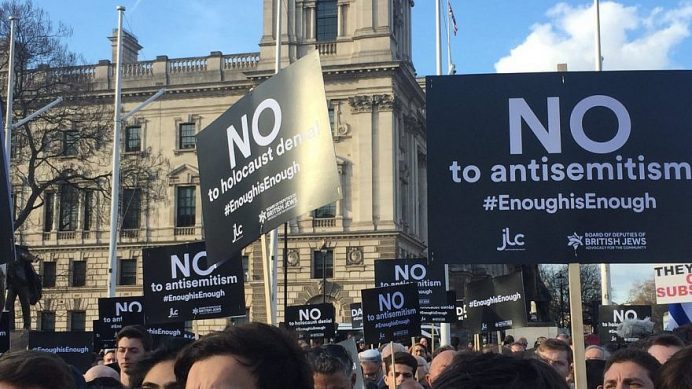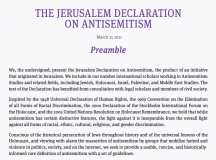University College London’s governing Council voted in November 2019 to adopt the IHRA (International Holocaust Remembrance Alliance) Working Definition of Antisemitism. A campaign against IHRA, which was already in existence at UCL, immediately gathered pace, and a concerted effort is now underway to persuade Council to reverse its decision. It is led by a small number of academics, several of them members of the Department of Hebrew and Jewish Studies, energetically supported by UCL Branch Officers of the Higher Education union UCU. One proposal currently under consideration is to replace IHRA with JDA (the Jerusalem Declaration on Antisemitism), a document drawn up recently under the auspices of the Van Leer Institute, Jerusalem, and published online in March 2021. We believe this would be a mistake. Our analysis is specifically concerned with the situation at UCL, and was written as a submission to Council, and in support of the view uniformly held by the presidents and officers of university Jewish Societies across the UK, that Jewish students need a definition of antisemitism that empowers them to call out antisemitism cloaked in political discourse, and that IHRA fulfils this purpose. We are publishing it now in the hope that it will assist debate in other universities where the question has arisen of how best to protect Jewish staff and especially Jewish students who face antisemitic bullying and harassment.
We believe UCL should not jettison IHRA for JDA.[1] The JDA Definition falls short of addressing contemporary antisemitism, in two major respects. The JDA Guidelines similarly fall short, in two major respects, and contradict the JDA Definition. The JDA as a whole is seriously defective. The JDA does not defend academic freedom.
Objection 1. The Definition falls short of addressing contemporary antisemitism
1A: The ‘Jews as Jews’ formulation
‘Antisemitism is discrimination, prejudice, hostility or violence against Jews as Jews (or Jewish institutions as Jewish).’ (JDA, Definition)
The formulation ‘Jews as Jews’ is unsatisfactory for two reasons.
First, the currency of antisemitic stereotypes allows antisemitism to take the form of hostility towards Jews ‘as capitalists’, ‘as bankers’, ‘as Communists’, etc., as opposed to Jews ‘as Jews’. The formulation is therefore defenceless against this typical response: ‘Jewish newspaper proprietors are more dangerous than Christian proprietors, because they act practically in accord with their fellow capitalist Jews all over the world. We have no feeling against Jews as Jews, but as nefarious capitalists, and poisoners of the well of public information, we denounce them.’[2] Again, the mother of Stephan Balliet, who attacked the synagogue in Halle in 2019, explained that ‘He had nothing against Jews as such. He has something against the people who stand behind financial power—but who doesn’t?’[3]
Second, the formulation ignores antisemitic discrimination, hostility, or prejudice directed against non-Jewish friends and supporters of Jews, the Jewish community, or Jewish causes. A recent attack on John Mann, Kier Starmer and Eric Pickles, labelling them as racists because of their support for the IHRA working definition and for Israel is an example.[4] An extremely serious example of this kind of antisemitism occurred recently at UCL:
As a Muslim student at UCL that is outspoken in my support of Jewish students on campus, I have often been subject to discrimination from other Muslim students on campus. In particular, I have been called a ‘race traitor’ and have been accused of engaging in ‘respectability politics’. On one occasion, during a protest organised by the UCL Friends of Palestine in the main quad, I was physically attacked by a student for expressing my views. I was later threatened by the student to remove a video containing evidence of this which was posted to social media.
The then-BME officer also contacted me (via Facebook messenger) threatening me with disciplinary action after they said they had received complaints about me from a number of students. No formal complaint was lodged and no action was taken, yet the BME officer sent me threatening messages in an attempt to silence me from speaking out in support of Jewish students.[5]
1B: The ‘Jews or Jewish institutions’ formulation
‘Antisemitism is discrimination, prejudice, hostility or violence against Jews as Jews (or Jewish institutions as Jewish).’
This is a further, grave deficiency. It misunderstands the nature of Jewish existence; it misunderstands the breadth of antisemitic attack. Judaism is neither a person nor an institution; nor is the Talmud. And yet attacks on the Jewish faith, books, and clergy, have always been understood as antisemitic. For example, Martin Luther’s antisemitic abuse includes the recommendation that ‘rabbis be forbidden to teach on pain of loss of life and limb. For they have justly forfeited the right to such an office by holding the poor Jews captive with the saying of Moses in which he commands them to obey their teachers.’ This infamous antisemitic statement would not be classified as such by JDA.
Judaism is a Jewish project. There are others – chief among which in present times is Zionism, the movement for the national revival of the Jewish people by the re-establishment of a Jewish state. It is another Jewish project. No Jewish project commands the assent of every Jew. Every Jewish project situates itself within the Jewish tradition, appeals to Jews, and is attacked by antisemites. When criticism of Zionism or the State of Israel is mendacious, essentialising, and demonising it is antisemitic—equating Zionism and Nazism, for example, or alleging that IDF soldiers harvest Palestinian organs.[6]
In its disregard of defamations directed at Judaism, the Talmud and the rabbis, the formulation overlooks the antisemitism of the medieval and early modern period; in its disregard of defamations directed at Zionism, Zionist writings, and the Jews who contributed (and contribute) to the Zionist enterprise, it overlooks the antisemitism of present times. Opposition to Zionism is of course not antisemitic as such, but it certainly can be antisemitic. For example, Jewish messianic antizionism is not antisemitic, although it has allied itself with antisemitic antizionists. By contrast the antizionism in the 1988 Hamas Covenant is patently antisemitic.
The formulation is also problematical in respect of ‘institution.’ It offers no guidance on which ‘Jewish institutions’ it applies to. Presumably it is not limited to buildings – synagogues, community centres, or cemeteries. But which organisations does it include – the United Synagogue, B’nai Brith, AIPAC? Does it apply to David Miller’s recent attacks on the Union of Jewish Students and the Community Security Trust?[7] This uncertainty disables the Definition from any effective application in these contexts.
Objection 2: The Guidelines fall short of addressing contemporary antisemitism
IHRA was developed because of the new forms that antisemitism had assumed since 1945, notably, Holocaust Denial and certain kinds of hostile expression towards Israel and Zionism. IHRA and JDA address Holocaust Denial and what JDA calls ‘classical antisemitism’, i.e. the myth of a world Jewish conspiracy, blood libel, etc., in broadly similar ways. The key differences between JDA and IHRA concern hostile expression towards Israel and Zionism.
JDA identifies ‘applying the symbols, images and negative stereotypes of classical antisemitism to the State of Israel’ as ‘on the face of it […] antisemitic’ (para. 6). Otherwise, the approach it takes to hostile expression towards Israel and Zionism is diametrically opposed to that of IHRA. Whereas IHRA identifies some of the kinds of hostile expression that can be antisemitic, depending on the ‘overall context’, JDA’s Guidelines state that precisely these kinds of criticism ‘on the face of it, are not antisemitic’.
The most pressing problem concerning antisemitism in the UK (and in UK universities in particular) today is identifying and confronting antisemitism cloaked in anti-Israel and anti-Zionist political discourse. Jewish Societies at universities across the country have identified this kind of antisemitism as the one that poses the greatest threat to their members’ safety and wellbeing and to the existence of Jewish Societies themselves.
It is well documented that antisemitism is sometimes cloaked in anti-Israel and anti-Zionist political discourse. Examples can be found below. Indeed some crude cases of antisemitism simply substitute ‘Zionist’ for ‘Jew’. For example, Khadim Hussain, a former Lord Mayor of Bradford, was suspended from the Labour Party for sharing a Facebook post complaining that the deaths of millions of Africans are not taught in schools but ‘your school education system only tells you about Anne Frank and the six million Zionists that were killed by Hitler’.[8]
Antisemitism and antizionism are sometimes tendentiously conflated by Zionists, and there are other cruder ways in which the accusation of antisemitism can be wilfully misused for political purposes, one recent example being the Prime Minister of Israel’s claim that the ICC is antisemitic. But the more harmful tendencies in the UK today and in the last few years, especially on university campuses, have been (a) to cloak antisemitism in political discourse, or to tolerate this, or to deny its reality or its importance; and (b) falsely to accuse Jews, Jewish groups, and their friends and supporters of the tendentious conflation—real as it is—when this is called out.
That is why it is vital that guidance acknowledges the reality of antisemitism cloaked in political discourse. IHRA does so, and JDA opposes IHRA precisely for this reason. JDA provides no guidance whatsoever on the kinds of criticism of Israel and Zionism that can qualify as antisemitic, beyond para. 6, quoted above. Instead, it legitimates various kinds of criticism of Israel and Zionism that IHRA identifies as potentially (although not necessarily) amounting to antisemitism of this kind.
In particular, the JDA guidelines fail to address two antisemitic tropes that are especially burdensome to Jews today.
2A: The ‘Zionists are Nazis’ trope
Comparing Zionism to Nazism, and Israelis to Nazis is common in contemporary ’antizionist’ discourse:
- An analysis of comparisons between Israel and Nazi Germany in contemporary German discourse includes the following email received by the Israeli Embassy in Berlin in 2012: ‘The Israeli State is a killer state. What is the difference between this state and the German terror system from 33-45? You do not need to be surprised that Jews are hated.’[9]
- From the EHRC Report: ‘How can we not have empathy with the Palestinians when they are up against these murdering, Zionest [sic] bastards. Their NAZI masters taught them well’ (p. 79).
- Multiple tweets by Tony Greenstein, the self-described ‘political activist with a focus on issues related to anti-racism, anti-facism and Palestine.’ (a) ‘AmYisraelChai is the Zionist equivalent of Heil Hitler’ (b) ‘yes the holocaust did happen and you Zios have been milking it ever since even though u collaborated with the Nazis’ (c) ‘Jewish Nazis.’[10]
‘ZioNazi’ is so widely used it is glossed on Wiktionary.org and urbandictionary.com.
This gives great offence to the generality of Jews. The offence they take is reasonable. There is a broad consensus that the ‘Nazi’ allegation is commonly antisemitic. This is the position of IHRA, which identifies ‘[d]rawing comparisons of contemporary Israeli policy to that of the Nazis’ as potentially antisemitic. And it is also the position of the EHRC.[11] Among the types of ‘antisemitic conduct’ identified by the Report (p. 31): ‘compar[ing] Israelis to Hitler or the Nazis.’ The NEC Disputes Panel imposed a formal warning on a Labour Party member for antisemitic posts on social media (including the one reproduced above from the EHRC Report), although the GLU recommended that the case should be referred to the NCC.
JDA does not acknowledge the fact that antisemitic discourse of this kind exists. Instead, it states that ‘it is not antisemitic, in and of itself, to compare Israel with other historical cases, including settler-colonialism or apartheid’ (para. 13). It tactfully avoids mentioning the comparison with Nazism explicitly, but the phrase ‘other historical cases’ evidently does include Nazism, and JDA’s implicit legitimisation of this comparison has been welcomed by supporters.[12]
The comparison between Israelis and the Nazis is not necessarily or invariably antisemitic. But the overall context of the comparison confirms that it is antisemitic in many cases, for example, in the Hamas Covenant:
In their Nazi treatment, the Jews made no exception for women or children. Their policy of striking fear in the heart is meant for all. […] The Zionist Nazi activities against our people will not last for long. […] The Zionist plan is limitless. After Palestine, the Zionists aspire to expand from the Nile to the Euphrates. When they will have digested the region they overtook, they will aspire to further expansion, and so on. Their plan is embodied in the ‘Protocols of the Elders of Zion’.[13]
Even the Chakrabarti Inquiry Report took a tougher line than the JDA: ‘I recommend that Labour members resist the use of Hitler, Nazi and Holocaust metaphors, distortions and comparisons in debates about Israel-Palestine in particular.’[14]
There are several instances of this trope among the testimonies of Jewish students at UCL. One concerns Ayo Ulatunji, formerly UCL Students’ Union BME officer and a member of the UCL Race Equality Steering Group, who resigned from the NUS NEC in 2018 after publishing a series of antisemitic tweets:
I honestly self identify as BME. I am part of a marginalised minority. Therefore I should feel represented by our BME officers. Especially last academic year I felt really unsafe, as our own BME officer Ayo Ulatunji took the lead in making this campus unsafe for Jews. For example saying: ‘comparing Israel to Nazis is not just a valid critique but it is a true statement to make.’ Herewith downplaying the atrocities of the holocaust.[15]
In another case, a student who identified themself as Jewish was subjected to verbal abuse by another student, including the statement that ‘Jews were the new Nazis and were treating Palestinians worse than the Nazis treated them.’ This happened in the presence of two members of staff, who did not intervene.[16]
2B: The ‘Antisemitism as smear’ trope
In Contemporary Left Antisemitism (2018), the sociologist David Hirsh writes:
Many anti-racist people in our time have been educated to recognise the accusation of antisemitism, rather than the antisemitism itself, as the dirty trick. They hear it as an attempt to smear and silence people who criticise Israel. Today’s antisemitism incorporates the notion that those who complain about antisemitism are the racists. It treats the opponents of antisemitism, not the antisemites, as the cynical ones; it treats opponents of antisemitism, not the antisemites, as the powerful ones.
He mentions in particular that ‘in 2006, after Ken Livingstone had been accused of antisemitism, he responded with a counter accusation that he was being accused in this way only in order to silence his criticism of Israel. This response I named the Livingstone formulation.’[17]
The 2020 EHRC Report treats as a type of ‘antisemitic conduct,’ ‘suggesting that complaints of antisemitism are fake or smears:’
Labour Party agents denied antisemitism in the Party and made comments dismissing complaints as ‘smears’ and ‘fake’. This conduct may target Jewish members as deliberately making up antisemitism complaints to undermine the Labour Party, and ignores legitimate and genuine complaints of antisemitism in the Party. These comments went beyond simply describing the agents’ own personal experience of antisemitism in the Party (p. 28).
It also found that allegations of fabrication contributed to unlawful harassment, that is ‘an intimidating, hostile, degrading, humiliating or offensive environment for members, and prospective members, of the Labour Party, particularly those who were Jewish’ (p. 111).
That Jews lie is an established antisemitic defamation. Martin Luther gave it canonical form in The Jews and Their Lies (1543). The historian Heinrich von Treitschke, polemicising against Jews over 300 years later, struck the same note: ‘Jews stand for “Lug und Trug” [lying and cheating].’[18] The immediate forebear to the current version of the trope is Holocaust Denial, in which the Jews are alleged to lie about exterminationist Nazi antisemitism. Now, it is the denial of antisemitism in the Labour Party, or of antizionist antisemitism, but the structure of the trope is the same.
It is therefore striking that the JDA is so strong on the Holocaust Denial version (para. 5), and so very silent on the current version.
There are several examples of this trope among the UCL students’ testimonies, some referring to the Holocaust, others not:
Spat at for wearing a Star of David necklace. Called a dirty jew terrorist for being half Israeli. Been told Israel shouldn’t exist and the Holocaust wasn’t as bad as Jews say.
I was asked if I want to kill Palestinian children and was told I am lieing [sic] about the Holocaust having happened.
Discussing an antisemitic attack in London, one student stated his belief that the event had been ‘exaggerated’ by the ‘Jewish media for attention.’
I was coming back to student accommodation from a night out and the reception was empty other than three members of staff behind reception. They were deep in conversation and as I was walking past them I overheard one of them (whom I later was told was actually a student) say that Jeremy Corbyn was not antisemitic and that the Jews were making it up. The other members of staff were smiling and nodding, I remember this really clearly, because it was equally as shocking as the comments.
During the student Union IHRA vote, when Jewish society president was describing the need for a definite definition of anti-Semitism on campus as Jews wearing kippot (skullcap) need to be able to walk around without being verbally harassed, one girl from behind me yelled out loudly, ‘that doesn’t happen, nobody cares!’ To which the people surrounding her laughed. The irony of this blatant racism by denying obvious anti-Semitism whilst during a vote for the need for more protection of Jews on campus was shocking. It made me feel uncomfortable that they could not recognise this clear anti-Semitism.[19]
Objection 3: The Guidelines contradict the Definition
‘Antisemitism is discrimination, prejudice, hostility or violence against Jews as Jews (or Jewish institutions as Jewish).’
To discriminate against Jews is, inter alia, to apply different standards to them (or some fraction of them, or their institutions, or projects) to standards applied to others. We do not need to look hard in antisemitism’s history to find the application of ‘double standards’ – it is constitutive of antisemitism’s history, after all. Here are some examples of double standards / discrimination:
- Adoption of the numerus clausus (arbitrary limits imposed on Jews in respect of, say, university admission).
- Imposing restrictions on the size or height or ornamentation of synagogues that are not imposed on churches.
- Representing the Rothschilds as an embodiment of capitalist evil but not the Barings or the Morgans.
- ‘Even as other popular subcultures in Germany were being accepted as legitimate under the influence of Romanticism and the social upheavals of rapid urbanisation during the first half of the 19th century, Jews continued to be regarded as outsiders. […] Yiddish continued to be mercilessly derided as a contemptible, repulsive jargon while local village dialects were upgraded in the spirit of romantic nationalism.’[20]
- Acknowledgement of the legitimacy of nationalism, except in Zionism’s case.
- Acknowledgment of the politically, culturally and morally diverse versions of nationalism, both generally and in specific instances (Italian nationalisms, British nationalisms, etc.), except in Zionism’s case.
Applying ‘double standards’ is ‘discriminatory.’
IHRA is clear. While, ‘criticism of Israel similar to that levelled against any other country cannot be regarded as antisemitic,’ ‘[a]pplying double standards by requiring of [Israel] a behavior not expected or demanded of any other democratic nation’ ‘could, taking into account the overall context,’ be ‘antisemiti[c].’
The JDA Definition is almost clear, or clear by implication: To apply double standards is to discriminate, and the Definition expressly includes discrimination. The JDA Guidelines, however, both equivocate (paras 14 and 15), and then – shockingly – themselves articulate double standards in relation to Israel / Palestine (paras 10 and 11).
The Guidelines’ equivocation: JDA’s awkwardness here may be glimpsed in the equivocation and omission in para 14: ‘In general, the same norms of debate that apply to other states and to other conflicts over national self-determination apply in the case of Israel and Palestine.’ The equivocation is in the opening two words (‘In general’), and the omission is of the word ‘should’ before ‘apply in the case of Israel.’ A non-equivocal version of this sentence reads: ‘The same norms of debate that apply to other states and to other conflicts over national self-determination should apply in the case of Israel and Palestine.’
Further equivocation follows in the next paragraph: ‘Criticism that some may see as … reflecting a “double standard,” …’ Note this shift to the subjective. In respect of an (objectively determined) double standard regarding a hostile judgment on Israel or Zionism, it would be hard to see how the JDA could maintain both its anti-discrimination position and its neutrality on ‘double standards.’
The Guidelines’ own double standards: In para 10, ‘Denying the right of Jews in the State of Israel to exist and flourish, collectively and individually, as Jews, in accordance with the principle of equality’ is ‘on the face of it … antisemitic.’ In para 11, ‘supporting the Palestinian demand for justice and the full grant of their political, national, civil and human rights, as encapsulated in international law’ is not ‘on the face of it … antisemitic.’ The double standard is in the absence of ‘national’ in para 10. The implication is that denying Jewish Israelis their national rights (‘collective’ existence is a lesser thing, and consistent with many sub-statal forms), while acknowledging the Palestinians’ own ‘full … national … rights,’ is not antisemitic – even though it would deny Jews what it would grant to Palestinians.
Objection 4: The JDA does not defend academic freedom
In the final section of the JDA, ‘About JDA,’ we read: ‘[The authors] reflected on the use of existing tools, including the working definition adopted by the International Holocaust Remembrance Alliance (IHRA), and its implications for academic freedom and freedom of expression.’ In one of the FAQs attached to the JDA, we read: ‘The signatories … share … a twofold commitment: fighting antisemitism and protecting freedom of expression on the basis of universal principles.’
Notwithstanding this concern for academic freedom, the JDA is almost silent on the academic boycott of Israel, which is an assault on academic freedom – not just the academic freedom of Israeli academics, but also of all those non-Israeli academics who wish to have contact with their Israeli colleagues, and for that reason is not supported by UCL.
Almost, but not quite silent on academic freedom. At para 14 of the Guidelines, we find: ‘Boycott, divestment and sanctions are commonplace, non-violent forms of political protest against states. In the Israeli case they are not, in and of themselves, antisemitic.’ As David Hirsh has pointed out, ‘when BDS is treated as legitimate in a social space, it brings with it antisemitic rhetoric, antisemitic emotions and antisemitic exclusions. We know this not “in and of itself” but empirically. It always does.’[21]
The IHRA definition should not be replaced with the JDA.
JDA’s express purpose is to ‘serve as a tool to identify, confront and raise awareness about antisemitism’. Comparing it with IHRA, which it is explicitly designed to replace (FAQ), suggests that the effect of adopting it in place of IHRA would not be to assist the fight against antisemitism. Like IHRA, it addresses ‘classical’ antisemitism and Holocaust denial. But these points of similarity cannot point to the likely effect of substituting JDA for IHRA. Only the differences can do that. And what they show plainly is that where antisemitism cloaked in political discourse is concerned, it will not serve as ‘a tool to identify, confront and raise awareness about antisemitism’, but as a tool to legitimise anti-Israel and anti-Zionist speech, whether or not it is antisemitic in purpose or in effect. The fact that it devotes 300 words to criticism of Israel/Zionism it says is not prima facie antisemitic (paras. 11-15) versus 15 words to criticism of Israel/Zionism it says is prima facie antisemitic (para. 6), is further evidence that this is what the document is designed to do.
The JDA cannot even manage to be straight about its intentions in relation to IHRA. On the one hand, ‘Institutions that have already adopted the IHRA Definition can use our text as a tool for interpreting it’ (Preamble); on the other hand, ‘if an organization has formally adopted the IHRA Definition it can use the JDA as a corrective to overcome the shortcomings of the IHRA Definition’ (FAQ). Yet – among its replications of IHRA, the JDA breaks with it on the fundamental question of ‘double standards’ and implicitly on the widespread and vile ‘Zionist / Nazi trope’ too. No question of ‘correction’ – still less, ‘interpretation’ – really arises. This is weasel language to conceal the extent of the gap between the two documents.
The JDA is evasive when it should be straightforward; it is opaque when it should be clear; it equivocates when it should be definite. It is both prolix and incomplete. It is deformed by its implicit politics: calling a truce with left wing antisemitism in the interests of unity against the right.[22] It is self-contradictory, it does not achieve what it says it sets out to do, it will leave its readers confused and uncertain about particular instances, and thus further demoralise Jews, while giving comfort to their antisemitic enemies.
References
[1] https://www.holocaustremembrance.com/resources/working-definitions-charters/working-definition-antisemitism; https://jerusalemdeclaration.org
[2] SDF newspaper, Justice, 21 January, 1893.
[3] The Times, 12 October 2019.
[4] Mondoweiss, 1 April 2021.
[5] Testimonies from January 2018 to January 2021, collected by the UCL Jewish Society [unpublished], testimony 24.
[6] https://www.commentarymagazine.com/jonathan-tobin/swedish-editor-is-no-raoul-wallenberg/
[7] https://www.ujs.org.uk/pattern_of_behaviour
[8] Independent, 23 March 2016.
[9] https://opr.degruyter.com/confronting-antisemitism-through-the-ages-a-historical-perspective/linda-giesel-comparisons-between-israel-and-nazi-germany-in-contemporary-german-discourse/
[10] Greenstein v Campaign Against Antisemitism [2020] EWHC 2951 (QB) (06 November 2020) http://www.bailii.org/ew/cases/EWHC/QB/2020/2951.html. The judge concluded: ‘The claimant’s tweet compares the people of Israel to the Nazis and, on any objective assessment, an honest person could have held the opinion that that was an antisemitic statement from the claimant.’
[11] https://www.equalityhumanrights.com/en/our-work/news/investigation-antisemitism-labour-party-finds-unlawful-acts-discrimination-and
[12] https://mondoweiss.net/2021/04/why-we-should-critically-welcome-the-jerusalem-declaration-on-antisemitism/
[13] https://avalon.law.yale.edu/20th_century/hamas.asp Hamas’s 2017 ‘Document of General Principles and Policies,’ which does not revoke the 1988 Charter, continues to propogate the phantasm of the World Jewish Conspiracy. ‘The Israeli entity,’ it explains, ‘is the plaything of the Zionist project and its base of aggression’ (para. 14); ‘The Zionist project poses a danger to international security and peace and to mankind and its interests and stability’ (para. 15). See A Document of General Principles and Policies | Hamas.
[14] See pp. 8, 27. https://labour.org.uk/wp-content/uploads/2017/10/Chakrabarti-Inquiry-Report-30June16.pdf
[15] Testimonies from January 2018 to January 2021, collected by the UCL Jewish Society [unpublished], testimony 3.
[16] Testimonies from January 2018 to January 2021, collected by the UCL Jewish Society [unpublished], testimony 17.
[17] D. Hirsh, Contemporary Left Antisemitism (London, 2018), p. 11.
[18] Shulamit Volkov, Germans, Jews, and Antisemites (Cambridge, 2006), p. 99.
[19] Testimonies from January 2018 to January 2021, collected by the UCL Jewish Society [unpublished], testimonies, 26, 22, 9, 17, 6.
[20] Shulamit Volkov, Germans, Jews, and Antisemites (Cambridge, 2006), pp. 195f.
[21] David Hirsh, ‘The Jerusalem Declaration defines the “community of the good”, not antisemitism,’ JC, 1 April 2021.
[22] David Hirsh, ‘The Jerusalem Declaration defines the “community of the good”, not antisemitism,’ JC, 1 April 2021. Hirsh concludes: ‘The Jerusalem Declaration does not help the fight against antisemitism, it de-legitimises IHRA, which is itself a tool in the fight against antisemitism.’





































